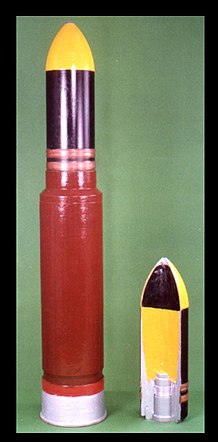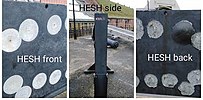High-explosive squash head
(HESH)
High explosive squash head (HESH) in British terminology, or high explosive plastic/plasticized (HEP) in American terminology,[1] is a type of explosive projectile which uses a plastic explosive that conforms to the surface of a target before detonating, to improve the transfer of explosive energy to the target. Squash head projectiles are similar to high explosive projectiles and are well suited to many of the same targets. However, while HESH projectiles are not armour-piercing, they can defeat armored targets by causing spall which can injure or kill a vehicle's occupants, and detonate some types of ammunition.[2]
Design
| External video | |
|---|---|
Function
HESH rounds are thin metal shells filled with inert material (like coal-tar pitch[3]), plastic explosive and a delayed-action base fuze. On impact, the inert material, followed by plastic explosive, is "squashed" against the surface of the target and spreads out to form a disc or "pat" of explosive. The inert material helps prevent premature detonation of the plastic explosive and sustains the impact pressure and temperature.[3][2]
Milliseconds later, the base fuze detonates the explosive, creating a shock wave that, owing to its large surface area and direct contact with the target, is transmitted through the material. In the metal armour of a tank, the compression shock wave is conducted through the armour to the point where it reaches the metal-air interface (the hollow crew compartment), where some of the energy is reflected as a tension wave, a phenomenon called impulsive loading. At the point where the compression and tension waves intersect, a high-stress zone is created in the metal, causing pieces of steel to be projected off the interior wall at high velocity.[2]
Effect
This fragmentation by blast wave is known as scabbing or spalling, with the fragments termed scabs or spall.[4][2]
Depending upon the armour thickness, a heavy piece of target material (4 to 10 kg for a 120 mm round used in Arjun MBT[4]) can separate out from the other end of the target with supersonic velocities. This spall is sufficient to permanently damage the essentials of a tank, igniting the ammunition or fuel storage and severely damaging the crew to achieve a "total kill" of the target. In general, the higher the armour thickness, the higher the scab weight will be.[2]
The fragmentation achieved by impulsive loading of armour block by an HESH round is more lethal compared to similar high explosive rounds.[4][2]
Example of light spalling damage caused by HESH rounds
Use
HESH rounds are mostly fired from guns with barrels with rifling rather than smoothbore. Rifling causes a projectile to spin, creating centrifugal force. This makes a HESH shell more effective on impact by increasing the surface area of contact for the explosive: the faster the spin, the larger the contact patch will be. In contrast, the centrifugal effect of rifling decreases the penetrating power of a high-explosive anti-tank (HEAT) shaped charge warhead because the centrifugal force of the spinning tends to disperse the shaped charge jet. HESH shells are not specifically designed to perforate the armour of vehicles, unlike HEAT rounds, with their shaped charge jets. HESH shells rely instead on transmitting a shock wave through solid steel armour.[2][5]
HESH ammunition has good general purpose use, being effective against most targets, though the round is generally used at relatively low velocities because high velocity excessively disperses the pat of explosive. While only effective against tanks without spaced armour or spall liners, the round is still favoured for combat demolition purposes. The flattened high-velocity explosive pat can destroy concrete constructions much faster than a HEAT round (which is designed to penetrate armour), and without the dangerous fragmentation of a traditional high explosive (HE) fragmentation round.[3]
History
HESH was developed by Dennistoun Burney in the 1940s for the UK's war effort, originally as an anti-fortification "wallbuster" munition for use against concrete. He also led British developments in recoilless rifles as a means to deliver the shell. An early application of the HESH principle was the AVRE's 165 mm demolition gun.[6]
HESH was found to be surprisingly effective against metallic armour and concrete structures as well. It was widely used as a primary round in most of the large calibre rifled guns.
Users

HESH rounds were fielded mainly by the British Army as the main explosive round of its main battle tanks during the Cold War. It was also used by other military forces, especially those that acquired the early post-World War II British 105 mm Royal Ordnance L7A1 tank gun, including Germany, India, Israel, and Sweden.
Since the 1970s, HESH ammunition has increasingly lost favour as armour designs have trended towards layered composites of hard metal and heat-resistant materials. This type of armour conducts shock waves poorly. Anti-spalling devices (spall liners), made of materials such as Kevlar, are commonly fitted to the interior surface of modern armoured vehicles to minimise spalling effects.[7] Another reason for the declining use of HESH rounds is the preference of most armies for smoothbore guns due to the use of high power armour-piercing fin-stabilized discarding sabot which significantly decrease the rifled barrel life.
British Challenger 1 and Challenger 2 tanks, India's Arjun tank (which has the same rifled 120 mm gun as the UK's MBTs) use HESH rounds as their primary ammunition. Amongst other ammunition types, the Stryker Mobile Gun System variant is to be equipped with a 105 mm HESH round for demolition and bunker-busting purposes. Argentina's TAM medium tanks, Canada's Leopard C1 and Leopard C2 main battle tanks (all of which mount the same 105 mm gun as the Centurion), the Australian Leopard AS1 main battle tank, and the Chinese VT-4 main battle tank (which mounts a 125 mm smoothbore gun) all use HESH rounds.
HESH rounds are also carried by armoured engineer vehicles; they are typically intended for use against fortifications rather than armoured fighting vehicles. A 165 mm HESH round is used by the United States Army for the main gun of the M728 combat engineer vehicle, an M60 tank equipped with a bulldozer blade. Similarly, the UK's Centurion AVRE was equipped with a short 165 mm gun solely for a 29 kg HESH shell.
Similar rounds

Based on the high-explosive squash head (HESH) round, a 120 mm thermobaric round was developed, which packed thermobaric explosives into the tank shells to increase the effectiveness against enemy bunkers and light armoured vehicles.[8]
The design and the development of the round was taken up by Armament Research and Development Establishment (ARDE). The rounds were designed for the Arjun MBT. The TB rounds contain a fuel-rich explosive composition called thermobaric explosive. As the name implies, the shells, when they hit a target, produce blast overpressure and heat energy for hundreds of milliseconds. The blast overpressure and heat energy damages enemy fortified structures like bunkers and buildings and soft targets like enemy personnel and light armoured vehicles.[9][10]
Gallery
See also
References
- ^ "Explosive_weapon_effects_web.pdf" (PDF). gichd.org. p. 22. Retrieved 2021-10-10.
{{cite web}}: CS1 maint: url-status (link) - ^ a b c d e f g Deshpande, P.U.; Prabhu, V.D.; Prabhakaran, K.V. (2003-10-01). "Impulsive Loading of Armour by High Explosive Squash Head Munition". Defence Science Journal. 53 (4): 357–365. doi:10.14429/dsj.53.2282.
- ^ a b c Roy, S. N., Armament Research & Development Establishment, Kirkee (29 March 2014). "Some design and functional aspects of squash head shell". Defence Science Journal. 12 (1): 55–58. doi:10.14429/dsj.12.6834 (inactive 2022-10-06).
{{cite journal}}: CS1 maint: DOI inactive as of October 2022 (link) CS1 maint: url-status (link) - ^ a b c "120 mm High Explosive Squash Head Mark-I". Defence Research and Development Organisation (DRDO), Government of India.
{{cite web}}: CS1 maint: url-status (link) Design aspects of 120 mm HESH round for Arjun MBT - ^ "115 mm, 120 mm & 125 mm Tank Guns". GICHD. Retrieved 2021-10-04.
- ^ Edgerton, David (2012). Britain's war machine : weapons, resources and experts in the Second World War,Chapter-8 Boffins. London: Penguin. ISBN 978-0-14-102610-7. OCLC 761379325.
- ^ "Modern Anti-Tank Ammunition". The Ontario Regiment RCAC Museum. 2021-07-30. Retrieved 2021-10-02.
- ^ "120 mm Thermobaric (TB) Ammunition For MBT Arjun | Defence Research and Development Organisation – DRDO, Ministry of Defence, Government of India". www.drdo.gov.in. Archived from the original on 2021-05-26. Retrieved 2021-05-26.
- ^ "120 mm Penetration Cum Blast (PCB) AND Thermobaric (TB) Ammunition For MBT Arjun | Defence Research and Development Organisation (DRDO), Ministry of Defence, Government of India". www.drdo.gov.in. Archived from the original on 26 May 2021.
- ^ "Fire-power of DRDO's Arjun Tank takes quantum jump with new ammunition: MoD". The Economic Times. Archived from the original on 2018-08-05. Retrieved 2021-09-23.
pl:Amunicja przeciwpancerna#przeciwpancerny pocisk odkształcalny







